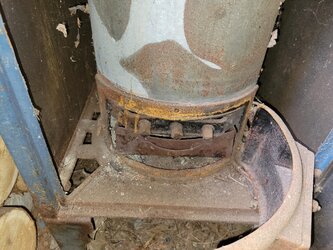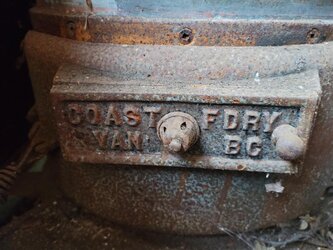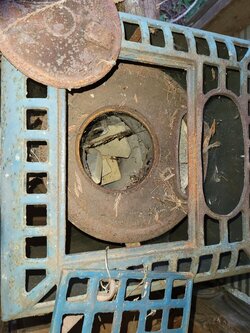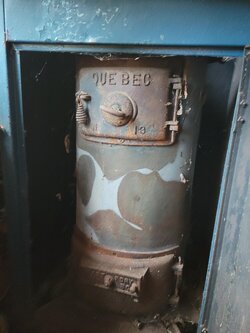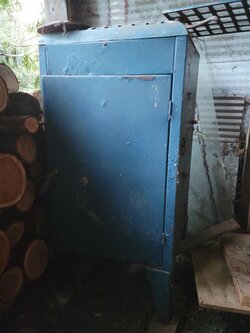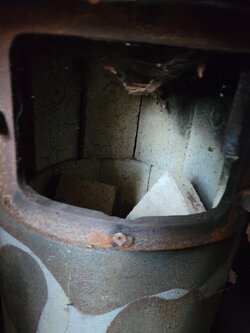Looks like the blue case makes a plenum around the inner firebox. Probably to prevent people, animals, children, from touching the stove itself, or direct heat up through a floor opening. If it had duct type outlets to connect vent ducts, it would be like a more modern coal furnace, but it gravity vents convected heat out the top and cool air or return air comes in the bottom where the air is coolest at floor level.
Stoves radiate heat in all directions by radiation. Another way to extract heat is through convection. All stoves use both since hot air also rises off radiant stoves. This is a convection heater that heats air instead of floors, walls, and objects by radiation. I would personally leave paint original, or use high temp stove paint if you must. (It's only original once) Many think convection heaters do not heat as well, but a BTU is a BTU and radiant stoves only feel hotter warming you. The hot air coming off this will heat a large area. The number on loading door is normally the diameter of burn pot.
Be careful with the brick, be very careful loading wood if that is what you will be using. You will probably not find replacement brick to match. If using wood, start It with both top and bottom air open. Once burning well, close bottom and only use top intake with wood. You may have to crack the bottom slightly, but not much. The bottom is for coal that requires lots of air to come up through it. Burning coal, use bottom air intake the most, only crack upper a little for oxygen to get to the top of fire to ignite coal gas. It will burn blue on top. You "can" burn wood in a coal stove, but not efficiently. It will get too much air burning too fast and too hot. If coal is available, that is the fuel to use.
Leaks around upper door is not as critical with coal as wood, since coal uses the air coming up through it. Wood will burn getting air from any direction, so a tighter stove is needed. If you won't be using it for constant heat, wood can be used for heat only when you need it. Much more efficient with coal.
That is not a parlor stove. They were a fancy coal burning stove for small areas, with Isinglass windows and nickel trim for in a parlor or entertaining room of a home. Like a smaller private TV room for entertaining guests today. They would heat with a kitchen coal stove, possibly have another stove in a dining room, and a parlor, and possibly others in bedrooms. It was common for travelers with horse and buggy to stop at a home to warm up in the front room, and tend the stove for the owners before leaving.
This is more utilitarian, but could have been used as a floor heater, or floor furnace. (probably called just a coal furnace) An open grate as large as the stove was centered in the home so the heat would rise up through it. A precursor to central heating. If you have exposed wood floors, look for a patched area covering the old opening, or open beams with added floor joists to fill in the opening where an open grate was. Not far from a chimney, and possibly remnants of a coal bin. One issue was the grate would get very hot for bare feet. As gas heat and natural gas became available, that was the downfall of coal ranges, and floor heaters were replace with gas floor heaters in the same opening. They had a flip switch to make the high limit switch closer to the hot plenum when in bare feet to keep grate cooler and you had to remember to flip the switch away from plenum overnight to heat the upstairs. I've removed similar to these and installed the gas type in my gas service business. Should have taken all the old furnaces when offered, but only took the cool stoves I replaced with gas. Bet some wish they had them back today.
Grease every moving part with high temp grease or silver anti-seize. Appears to be in very good shape.
